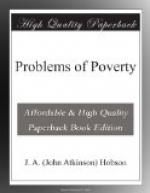The slow, intermittent, and fragmentary manner in which labour-unions have been hitherto conducted even in the stronger trades, is a fact which has perhaps done more to hide the true parallelism in the evolution of capital and labour. The path traced above has not yet been traversed by the bulk of English working men, while, as has been shown, working women have hardly begun to contemplate the first step. But the uneven rate of development, in the case of capital and labour, should not blind us to the law which is operating in both movements. The representative relation between capital and labour is no longer that between a single employer and a number of individual working men, each of the latter making his own terms with the former for the sale of his labour, but between a large company or union of employers on the one hand, and a union of workmen on the other. The last few years have consolidated and secured this relation in the case of such powerful staple industries in England as mining, ship-building, iron-work, and even in the weaker low-skilled industries the relation is gradually winning recognition.
Sec. 7. Probabilities of Industrial Peace.—This concentrative process at work in both capital and labour, consolidating the smaller industrial units into larger ones, and tending to a unification of the masses of capital and of labour engaged respectively in the several industries, is at the present time by far the most important factor of industrial history. How far these two movements in capital and in labour react on one another for peace or for strife is a delicate and difficult question. Consideration of the common interest of capital and labour dependent on their necessary co-operation in industry might lead us to suppose that along with the growing organization of the two forces there would come an increased recognition of this community of interest which would make constantly and rapidly for industrial peace. But we must not be misled by the stress which is rightly laid on the identity of interest between capital and labour. The identity which is based on the general consideration that capital and labour are both required in the conduct of a given business, is no effective guarantee against a genuine clash of interests between the actual forms of capital and the labourers engaged at a given time in that particular business. To a body of employes who are seeking to extract a rise of wages from their employers, or to resist a reduction of wages, it is no argument to point out that if they gain their point the fall of profit in their employers’ business will have some effect in lowering the average interest on invested capital, and will thus prevent the accumulation of some capital which would have helped to find employment for some more working men. The immediate direct interests of a particular body of workmen and a particular company of employers may, and frequently will, impel them to a course directly opposed to the wider interests




